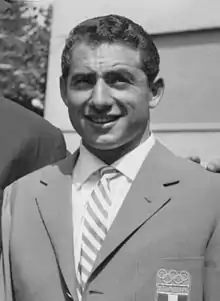Cycling at the 1960 Summer Olympics – Men's track time trial
The men's track time trial at the 1960 Summer Olympics in Rome, Italy, was held on 26 August 1960. There were 25 participants from 25 nations, with each nation limited to one competitor.[1] The event was won by Sante Gaiardoni of Italy, the nation's second consecutive victory (tying Australia and France for most all-time) and third consecutive podium appearance in the men's track time trial. Dieter Gieseler won the United Team of Germany's first medal in the event in its first appearance with his silver; it was the first medal for a German athelte since 1936. Rostislav Vargashkin's bronze was the first medal for the Soviet Union in the event.
| Men's cycling track time trial at the Games of the XVII Olympiad | ||||||||||
|---|---|---|---|---|---|---|---|---|---|---|
 Sante Gaiardoni | ||||||||||
| Venue | Olympic Velodrome, Rome | |||||||||
| Date | 26 August 1960 | |||||||||
| Competitors | 25 from 25 nations | |||||||||
| Winning time | 1:07.27 WR | |||||||||
| Medalists | ||||||||||
| ||||||||||
| Cycling at the 1960 Summer Olympics | |
|---|---|
_pictogram.svg.png.webp) | |
| Road events | |
| Individual road race | men |
| Team time trial | men |
| Track events | |
| Track time trial | men |
| Sprint | men |
| Tandem | men |
| Team pursuit | men |
Background
This was the eighth appearance of the event, which had previously been held in 1896 and every Games since 1928. It would be held every Games until being dropped from the programme after 2004. Returning cyclists from 1956 were fifth-place finisher Luis Serra of Uruguay, eighth-place finisher Warwick Dalton of New Zealand, ninth-place finisher Anésio Argenton of Brazil, tenth-place finisher Allen Bell of the United States, twelfth-place finisher Tetsuo Osawa of Japan, and eighteenth-place finisher Paul Nyman of Finland. Sante Gaiardoni was the sprint world champion (having placed second two times in a row before finally winning in 1960) and had set the amateur world record in the time trial a month and a half before the Games.[2]
The British West Indies made its debut in the men's track time trial. East and West Germany competed as the United Team of Germany for the first time. France and Great Britain each made their eighth appearance, having competed at every appearance of the event.
Competition format
The event was a time trial on the track, with each cyclist competing separately to attempt to achieve the fastest time. Each cyclist raced one kilometre from a standing start. This was the first time that results were measured to the hundredth of a second instead of the tenth of a second.[2][3]
Records
The following were the world and Olympic records prior to the competition.
| World record | 1:07.50 | Rome, Italy | 3 July 1960 | |
| Olympic record | 1:09.8 | Melbourne, Australia | 6 December 1956 |
Piet van der Touw was the first to break the Olympic record, recording a time of 1:09.20. Dieter Gieseler bettered that, to 1:08.75. But Sante Gaiardoni, the world record holder, broke his own world record with a time of 1:07.27. Rostislav Vargashkin and Ian Chapman also finished faster than the old Olympic record.
Schedule
All times are Central European Time (UTC+1)
| Date | Time | Round |
|---|---|---|
| Friday, 26 August 1960 | "night" | Final |
Results
| Rank | Cyclist | Nation | Time | Notes |
|---|---|---|---|---|
| Sante Gaiardoni | 1:07.27 | WR | ||
| Dieter Gieseler | 1:08.75 | |||
| Rostislav Vargashkin | 1:08.86 | |||
| 4 | Piet van der Touw | 1:09.20 | ||
| 5 | Ian Chapman | 1:09.55 | ||
| 6 | Anésio Argenton | 1:09.96 | ||
| 7 | Jean Govaerts | 1:10.23 | ||
| 8 | Josef Helbling | 1:10.42 | ||
| 9 | Les Haupt | 1:10.61 | ||
| 10 | János Söre | 1:10.63 | ||
| 11 | Warwick Dalton | 1:10.68 | ||
| 12 | Ion Ioniţă | 1:10.91 | ||
| 13 | Allen Bell | 1:11.33 | ||
| 14 | Luis Serra | 1:11.42 | ||
| 15 | Mauricio Mata | 1:11.61 | ||
| 16 | Michel Scob | 1:11.65 | ||
| 17 | Karl Barton | 1:11.72 | ||
| 18 | Boncho Novakov | 1:11.73 | ||
| 19 | Tetsuo Osawa | 1:11.86 | ||
| 20 | Günther Kriz | 1:12.58 | ||
| 21 | Paul Nyman | 1:14.11 | ||
| 22 | Diego Calero | 1:14.18 | ||
| 23 | Clyde Rimple | 1:16.08 | ||
| 24 | Michael Horgan | 1:17.18 | ||
| 25 | Muhammad Ashiq | 1:20.17 |
References
- "Cycling at the 1960 Rome Summer Games: Men's 1000m Time Trial". sports-reference.com. Archived from the original on 18 April 2020. Retrieved 28 July 2014.
- "1,000 metres Time Trial, Men". Olympedia. Retrieved 11 November 2020.
- Official Report, vol. 2, p. 337.